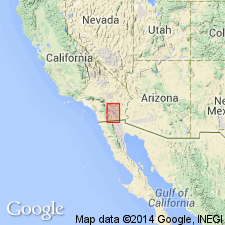- Usage in publication:
-
- Alverson Canyon formation
- Modifications:
-
- Areal extent
- Dominant lithology:
-
- Andesite
- Tuff
- AAPG geologic province:
-
- Salton basin
Tarbet, L.A., and Holman, W.H., 1944, Stratigraphy and micropaleontology of the west side of Imperial Valley, California [abs.]: American Association of Petroleum Geologists Bulletin, v. 28, no. 12, p. 1781-1782.
Summary:
Pg. 1781-1782. Alverson Canyon formation. Nonmarine unassorted sediments and associated basic igneous flows and tuffaceous sediments unconformably overlying all older rocks. Unfossiliferous. Thickness 0 to 700 feet. [Is younger than Split Mountain formation and older than Imperial formation.] Age is Miocene(?).
Source: Publication; US geologic names lexicon (USGS Bull. 1200, p. 70-71).
- Usage in publication:
-
- Alverson Canyon formation
- Modifications:
-
- Age modified
- AAPG geologic province:
-
- Salton basin
Tarbet, L.A., 1951, Imperial Valley, [California]: American Association of Petroleum Geologists Bulletin, v. 35, no. 2, p. 260-263.
Summary:
Pg. 260, 261 (fig. 40). Alverson Canyon formation. Nonmarine sandstone and conglomerates associated with volcanic flows and tuffaceous sediments. Thickness at least 700 feet. As it rests directly on the basement complex, it may be equivalent in age to Split Mountain formation. However, Split Mountain formation probably pre-dates the volcanic activity prevalent in the Alverson Canyon formation as no volcanic debris was observed in the Split Mountain formation. Age is considered Miocene(?).
Source: Publication; US geologic names lexicon (USGS Bull. 1200, p. 70-71).

- Usage in publication:
-
- Alverson andesite lava
- Modifications:
-
- Principal reference
- Dominant lithology:
-
- Andesite
- AAPG geologic province:
-
- Salton basin
Summary:
Pg. 22. Alverson andesite lava. Dark-brown basic andesite. About 400 feet thick in Alverson Canyon and about 700 feet thick at east end of Coyote Mountains where it is associated with tuff and breccia. Overlies Split Mountain conglomerate and older basement rocks in western foothills of Coyote Wells Valley, in Coyote Mountains, and in Fish Creek Mountains; in some areas underlies the Fish Creek gypsum (new) and (or) Imperial formation. Age is probably Miocene.
Type locality: Alverson Canyon [Fossil Canyon, in E/2 sec. 10, T. 16 S., R. 9 E., Carrizo Mountain 7.5-min quadrangle, Imperial Co., eastern Coyote Mountains, Yuha Desert Recreation Area, southern CA].
[Additional locality information from USGS GNIS database, USGS historical topographic map collection TopoView; accessed April 8, 2018.]
Source: Publication; US geologic names lexicon (USGS Bull. 1200, p. 70).
- Usage in publication:
-
- Alverson Andesite
- Alverson Canyon Formation†
- Modifications:
-
- Areal extent
- AAPG geologic province:
-
- Salton basin
Woodard, G.D., 1974, Redefinition of Cenozoic stratigraphic column in Split Mountain gorge, Imperial Valley, California: American Association of Petroleum Geologists Bulletin, v. 58, no. 3, p. 521-539.
Summary:
Pg. 522 (fig. 2), 523-524. Alverson Andesite of Dibblee (1954). Dark mauve-gray plagioclase-hornblende andesite lava interbedded with gray andesite tuff. Maximum thickness about 400 feet (120 m). Notable exposures outside of study area, 5 miles (8 km) southeast of Red Rock Canyon in Fish Creek Mountains. Nonconformably overlies coarse arenaceous and conglomeratic strata [=? upper member] of Miocene Anza Formation or pre-Cenozoic granitic basement. Is older than Split Mountain Formation and Fish Creek Gypsum. Age is Miocene.
Name Alverson Andesite is preferred "Because the original term, Alverson Canyon Formation, is no longer in current usage, and as the Alverson Andesite more aptly stresses the genetic nature of this lithostratigraphic unit, the former name should be abandoned."
Source: Publication.
For more information, please contact Nancy Stamm, Geologic Names Committee Secretary.
Asterisk (*) indicates published by U.S. Geological Survey authors.
"No current usage" (†) implies that a name has been abandoned or has fallen into disuse. Former usage and, if known, replacement name given in parentheses ( ).
Slash (/) indicates name conflicts with nomenclatural guidelines (CSN, 1933; ACSN, 1961, 1970; NACSN, 1983, 2005, 2021). May be explained within brackets ([ ]).

